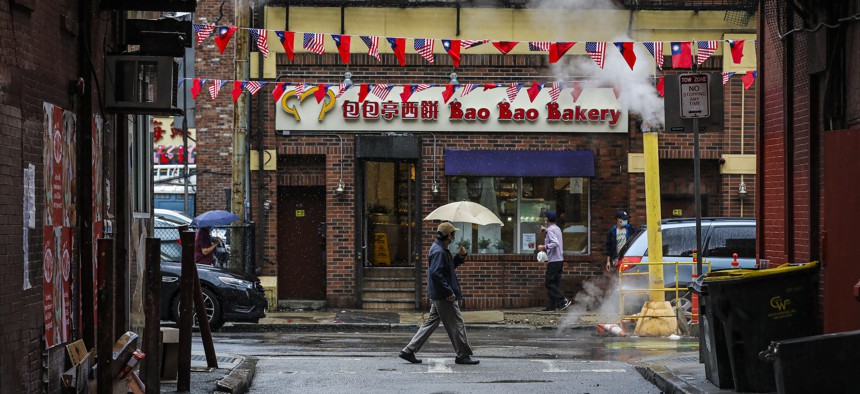Devil in the details: How outdated zoning code stymies development

A pedestrian walks through the Chinatown neighborhood of Boston. The city is working to overhaul its zoning code in an effort to build more equitable and sustainable communities. Erin Clark/The Boston Globe via Getty Images
With an analysis of its antiquated zoning laws and a newly restructured planning department, Boston is laying the groundwork to address housing shortages and meet its sustainability goals.
No one expects a major city’s zoning code to be an enjoyable, leisurely read. But they also don’t expect it to be “bloated, outdated, inconsistent and inequitable.”
That is how Boston’s nearly 4,000-page ordinance was described by an outside consultant brought in to analyze it. Filled with antiquated and sometimes offensive language, the code’s text makes references to orphanages and boarding houses, and to technology like “automatic telephone exchanges,” “phonographs” and “outdoor payphones.” More alarming, the code uses phrases like “drug addicts” and “mentally retarded.”
The review of the city’s zoning code comes as Mayor Michelle Wu and a newly restructured planning department are taking on the behemoth task of reforming the ordinance to address housing shortages and meet sustainability goals. A fresh analysis of the city’s zoning code will serve as the foundation for that work.
Beantown isn’t alone in its desire to revisit old zoning laws. As the housing shortage grows more acute, communities nationwide are reconsidering how zoning regulations affect residential developments. Zoning practices became widespread about a century ago to protect residents from the impacts of industrial and commercial developments. But they also contributed to systemic housing segregation by race and income, and the Biden administration has been outspoken in calling for localities to reform zoning laws.
Boston commissioned Sara Bronin, Cornell professor and director of the National Zoning Atlas, to assess the city’s zoning code. Bronin clearly did not mince words in her final report. In addition to the adjectives above, Bronin said the city’s ordinance deviated “greatly from the typical American zoning code” and had “become detached from modern realities—and ignored in practice.”
Indeed, Boston appears to be in a league of its own when it comes to the length and complexity of its zoning code and the cleanup it faces.
Other cities similar to Boston—including Detroit, Las Vegas and Portland, Oregon—have zoning codes that are, on average, about 780 pages. At 3,791 pages long, Boston’s is not only atypical of cities with roughly 600,000 residents, but it beats larger cities’ codes. New York City has 13 times more residents and six times as much land, but its zoning code is a cool 2,751 pages.
The magnitude of Boston’s zoning code is, in part, due to “hundreds of piecemeal revisions,” Bronin wrote. The changes “have been made without a comprehensive vision for what they are intended to achieve,” the report stated, and create additional barriers and hurdles for property owners looking to make what they thought would be simple changes to their homes and businesses.
Boston’s code is filled with “nonconformities,” which are discrepancies between what the zoning laws call for on a particular parcel and what actually exists there. Nonconformities are typically not an issue until the property owner wants to make a modification.
Take, for example, an existing duplex in an area that is newly zoned exclusively for single-family housing, Bronin wrote. If the property owners wanted to add an enclosed porch, they would need to either apply for a variance—which can be a lengthy and confusing process—or convert the duplex into a single-family home. Not only could applying for a variance in Boston take as long as six months, it could also cost the homeowners upwards of $10,000. Rules around nonconformities like this can discourage property owners from improving their homes, which can ultimately result in lower property values and houses falling into disrepair.
The language throughout the Boston zoning code underscores just how outdated the document is. Remember, it uses outdated terms like “servants” and “payphones.” The code saw its last major update in 1964, and even that version pulled largely from the 1924 edition.
“Though these terms may appear superficial and easily remedied, they reflect a legal document out of touch with modern times,” Bronin wrote.
She suggested a complete overhaul of Boston’s zoning code, which could take three or four years. It’s an idea that Wu’s administration appears open to.
The commissioned report is one of the latest steps in the city’s efforts to transform zoning. The Boston Planning and Development Agency is creating new teams that will focus specifically on zoning reform and compliance. These teams will increase the department’s capacity to foster more proactive changes to the code and keep the long-term vision of citywide housing reform in mind.
Bronin’s report lays some of the groundwork for Wu’s Squares and Streets initiative, which aims to enhance neighborhood centers near transit with mixed-use development. The initiative—set to kick off this fall—will require zoning changes in targeted neighborhoods and will be the first test of the city’s revamped planning agency.
“One of the most impactful responsibilities of city government is to set the rules for how our neighborhoods grow,” Wu said at the Greater Boston Chamber of Commerce Government Affairs Forum on Wednesday. “Reforming our planning process and zoning code will be a sea change for our city, helping to fulfill a commitment for predictability and equity to meet the needs of our communities.”






